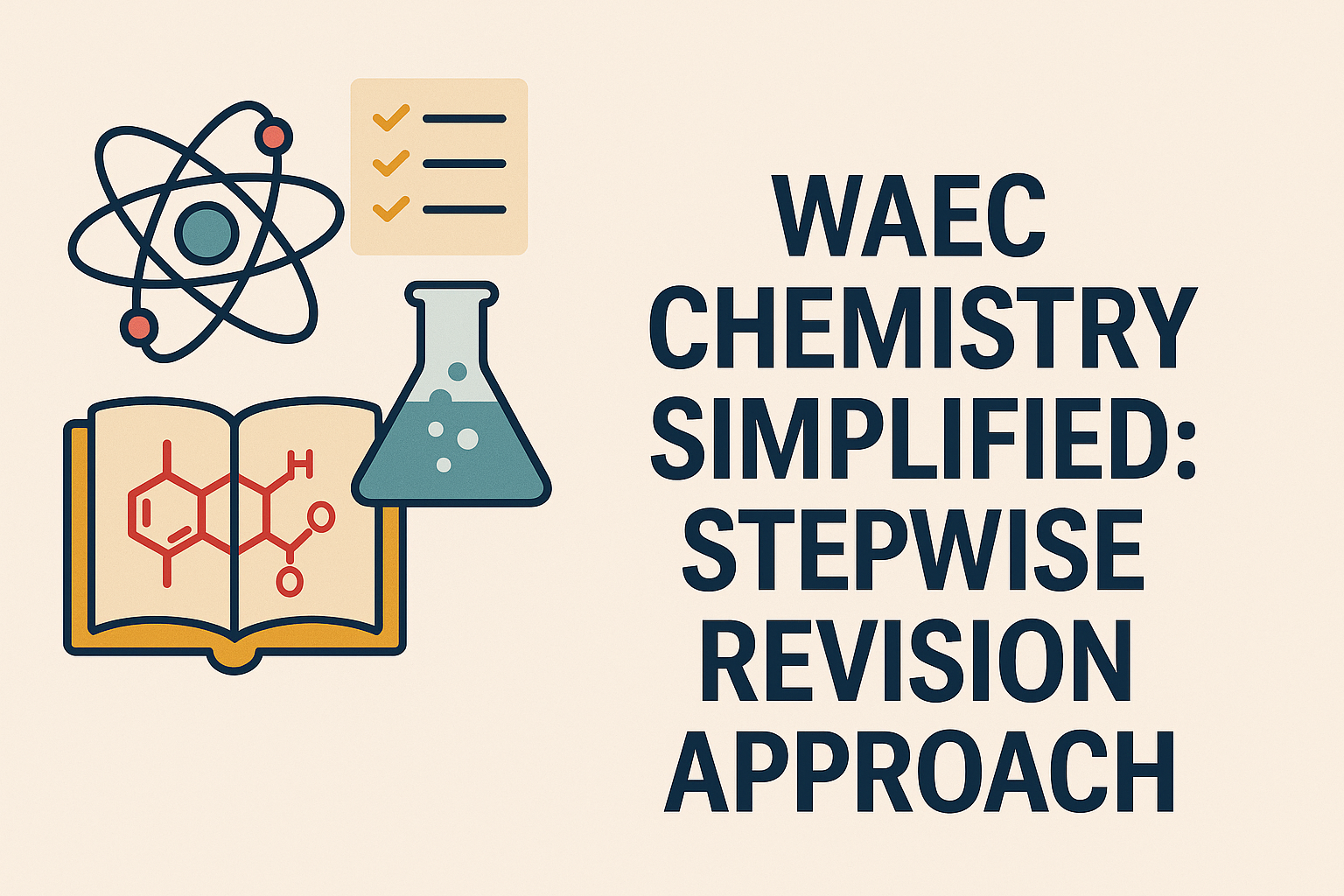1. Introduction
WAEC Chemistry evaluates candidates’ understanding of matter’s structure and reactions, blending theoretical questions, practical tasks, and data analysis. Excelling requires grasping core concepts in physical, organic, and inorganic chemistry, along with laboratory proficiency.
This guide lays out a structured revision approach: dissect the syllabus, explain fundamental theories, demonstrate stepwise problem-solving, and provide targeted practice drills. Whether you’re tackling reaction mechanisms or titration curves, this article will streamline your study for maximum efficiency.
Let’s simplify WAEC Chemistry together, turning complex equations into clear, solvable tasks.
2. Deep Dive: Syllabus & Topic Breakdown
2.1 Physical Chemistry
- Mole Concept & Stoichiometry: Calculations with moles, limiting reagents.
- Thermochemistry: Enthalpy changes, calorimetry.
- Chemical Equilibrium: Kc, Le Chatelier’s principle.
2.2 Inorganic Chemistry
- Periodic Table Trends: Atomic structure, periodic properties.
- Acid-Base Chemistry: pH, titrations, indicators.
- Transition Metals: Complex ions, colours, catalytic properties.
2.3 Organic Chemistry
- Functional Groups & Nomenclature: Alkanes, alkenes, alcohols, carboxylic acids.
- Reaction Mechanisms: Substitution, elimination, addition.
- Polymers & Biomolecules: Basic polymerisation, carbohydrates.
2.4 Data Analysis & Practical Skills
- Graph Interpretation: Rate vs concentration plots.
- Laboratory Techniques: Titration setup, qualitative analysis tests.
- Safety Protocols: Handling acids, bases, organic solvents.
3. Exam Strategy Tips
3.1 Structured Problem Solving
- Read Carefully: Identify given data and required outputs.
- Plan Calculation: Choose formulas (e.g., PV=nRT).
- Execute: Show clear steps; keep significant figures.
- Check: Confirm units and magnitude.
3.2 Practical Question Tips
- Label apparatus diagrams clearly; list procedure steps.
- For titration, note colour change and endpoint.
3.3 Graph & Data Handling
- Describe trends before answering; reference axis labels.
- Identify anomalies and propose explanations.
3.4 Time Management
- Allocate 30 minutes to practical/theory mix, 1 hour to calculations.
- Flag lengthy calculations to return if time allows.
3.5 Minimizing Careless Errors
- Re-read questions; ensure correct chemical formulas.
- Use consistent notation for states (s, l, g, aq).
4. Subject-Specific Overview
4.1 Thermochemistry Insights
Relate enthalpy concepts to Hess’s law examples.
4.2 Periodic Properties Application
Predict reactivity using electronegativity and ionization trends.
4.3 Organic Mechanism Clarity
Map out electron flow in mechanisms; practice curved-arrow notation.
4.4 Lab Skills Integration
Design mini-experiments: chromatography tests for pigments.
5. Practice & Resources
5.1 Textbook Recommendations
- Spectrum WAEC Chemistry by Spectrum Publications
- Objective Chemistry by Africana-FEP
5.2 Online Platforms
| Resource | Features | Access |
|---|---|---|
| Chemguide | Detailed theory and mechanism guides | Free |
| myCBTPrep | Timed Chemistry mocks | Free/Paid |
| eduCBA | Video lessons and quizzes | Free/Paid |
5.3 Mobile Apps
- Chemistry Lab Guru: Virtual titrations.
- Reaction Flashcards: Organic reaction drills.
5.4 Mock Exam Strategy
- Bi-weekly full WAEC practice.
- Post-mock: create error logs and focused revision plans.
6. Conclusion
Mastering WAEC Chemistry hinges on understanding core concepts, practicing problems step-by-step, and honing practical skills. By following a structured revision plan, leveraging quality resources, and simulating exam conditions, you’ll enhance both speed and accuracy.
Begin today: tackle one stoichiometry problem, label a lab setup, and review one organic mechanism. Your streamlined path to WAEC Chemistry success starts now.
